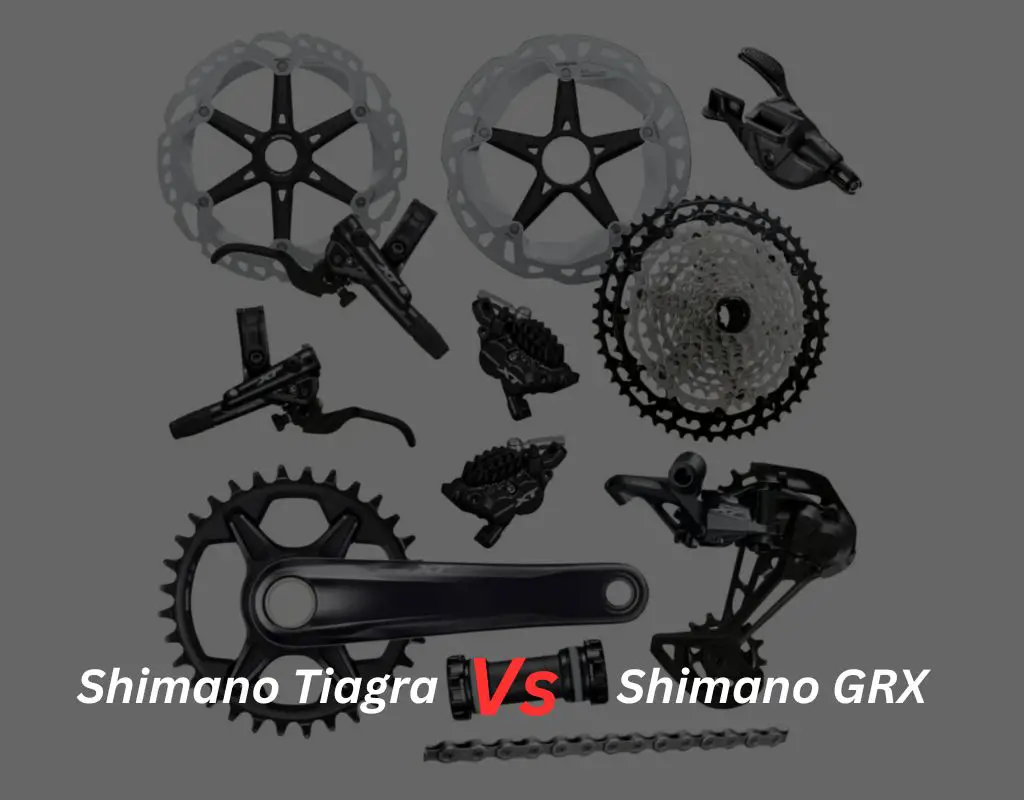
Tiagra and GRX are two groupsets from Shimano, a leading manufacturer of bicycle components. Groupsets are collections of parts that work together to control the speed and braking of a bike.
Tiagra is designed for road bikes, while GRX is the first dedicated gravel bike groupset. Both are 10-speed options from Shimano, but they have some important differences that you should consider before making your decision.
Here is a comprehensive comparison of Tiagra vs GRX, based on their features, performance, compatibility, and price.
Features
Tiagra
Tiagra is Shimano’s entry-level road groupset, designed for road bikes with drop bars. It offers reliable shifting and braking performance, with a sleek and ergonomic design. Tiagra has 2 versions: 4700 for rim brakes and 4720 for hydraulic disc brakes.
GRX
GRX is Shimano’s first dedicated gravel groupset, designed for mixed terrain riding with drop bars. It offers enhanced control, comfort, and confidence on rough surfaces, with a range of options to suit different preferences and budgets. GRX has 3 versions: RX400 for 10-speed, RX600 for 11-speed, and RX800 for 11-speed with higher-end components.
Related: Tiagra vs. Deore: A Comprehensive Comparison
Performance
Tiagra and GRX have different gearing ranges and ratios, which affect how they perform on different terrains and gradients.
Tiagra
Tiagra has a standard road cassette with 11-34 teeth, and a compact road crankset with 50-34 teeth. This gives it a high gear range for fast riding on flat roads, but a limited low gear range for climbing steep hills or riding on loose gravel.
GRX
GRX has a wider cassette with 11-36 teeth and a sub-compact crankset with 46-30 teeth. This gives it a lower gear range for tackling challenging climbs or riding on rough terrain, but a narrower high gear range for cruising on smooth roads.
GRX has a clutch mechanism in the rear derailleur, which reduces chain slap and improves chain retention on bumpy surfaces.
Compatibility
Tiagra and GRX are not fully compatible with each other, as they have different cable pull ratios and chainline specifications.
Tiagra
Tiagra 4700 shifters are compatible with GRX RX400 derailleurs (front and rear), but not with 105 5700 and Ultegra 6700 shifters. The 10-speed RX400 rear derailleur is more understated, weighing more and featuring budget specs such as bushings rather than ball bearings for the jockey wheels.
GRX RX400 shifters are only compatible with hydraulic disc brakes, while Tiagra 4720 shifters are only compatible with Tiagra 4720 calipers. Therefore, you cannot mix and match Tiagra and GRX components without compromising the performance or safety of your braking system.
Related: Sora vs. GRX: Detailed Comparison
Price
Tiagra is cheaper than GRX, as it is a lower-end groupset with fewer features and technology. The price difference between Tiagra and GRX depends on the version and configuration you choose, but you can expect to pay around $200-$300 more for a GRX groupset than a Tiagra one.
Which Groupset Should You Choose?
The answer depends on your personal preference, riding style, and budget. Both groupsets offer reliable performance and smooth shifting, but they have different strengths that cater to specific riding needs.
Tiagra
- Suitable for riders who prefer fast and smooth roads, or who are on a tight budget.
- Offers a higher gear range for faster riding on flat roads, but a limited low gear range for climbing steep hills or riding on loose gravel.
- Comes with standard road cassettes and compact road cranksets.
- Compatible with Shimano’s HG freehub body for versatile cassette options.
GRX
- Suitable for riders seeking more control and comfort on rough and varied terrain, or who are willing to pay more for better performance and durability.
- Offers a wider gear range for tackling challenging climbs and riding on rough terrain.
- Comes with wider cassettes and sub-compact cranksets.
- Compatible with Shimano’s Microspline or HG freehub body, depending on the version.
Related: Is Shimano Tiagra Good?
Conclusion
Tiagra and GRX are both good options for gravel bikes, but they have different strengths and weaknesses.
Tiagra is more suitable for riders who prefer fast and smooth roads or who are on a tight budget. GRX is more suitable for riders who seek more control and comfort on rough and varied terrain or who are willing to pay more for better performance and durability.
Consider your riding style and preferences carefully when making your decision between Tiagra and GRX. Each groupset offers distinct advantages, and the right choice depends on your individual needs and budget.
